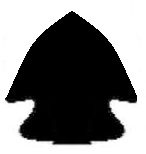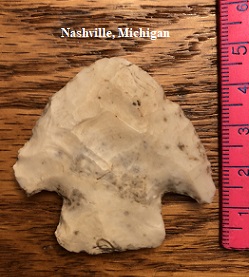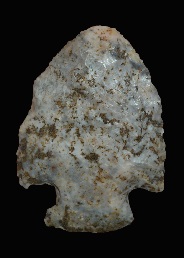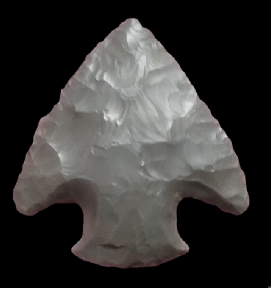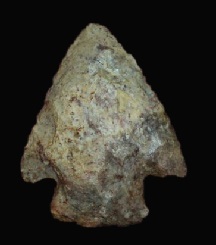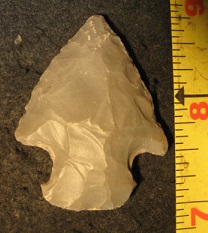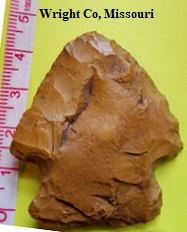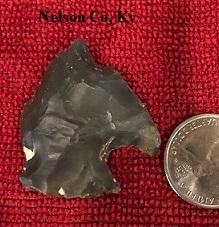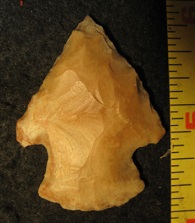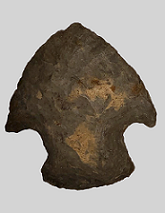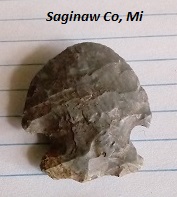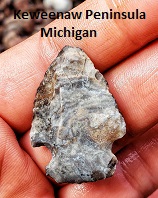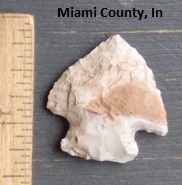Other Websites with Detailed Information:
Name Details:
Named By: Anta Montet-White
Named For: Type Site
Date Identified: 1968
Type Site: Manker Site, Illinois
Manker
Cluster: Snyders Cluster
Commonly Utilized Material:
Commonly available materials and heat treated cherts
Date:
Cultural Period:
2,200 - 1,800 B.P.
Middle
Woodland
Roman Warm
Havana
Hopewell Culture
Glacial Period:
Culture:
Outline is Representative of Size and Shape:
Description of Physical Characteristics and Flaking Pattern:
This is a
thick broad medium corner notch to expanding stemmed point with a triangular to ovate appearance. This point generally has an elliptical cross section, but some examples may have a
flattened cross section.
Notches are broad and deep forming shoulders that are barbed with a short stem. Most stems are expanding, but some points may
only have a slight expanding stem. The base is convex
and lacks basal grinding. This point is manufactured
using percussion flaking with marginal pressure flaking forming a random flaking pattern.
This point does not have a high quality of workmanship.
Size Measurements: Total Length
- 40 to 80 mm, Stem Length - 12 to 22 mm, Blade Width - 25 to 50 mm, Neck Width - 19 to 25 mm, Stem Width - 21 to 34 mm, Thickness - 8 to 9 mm
Distribution:
Distribution Comments:
This point is primarily recognized in the
Wabash Valley of southeastern Illinois, Indiana, and into western Ohio.
They have been reported into southern Ohio and the Upper Peninsula of
Michigan. However, they may have the same distribution as the
Snyders type. These points are rarely found in Wisconsin and
Minnesota.
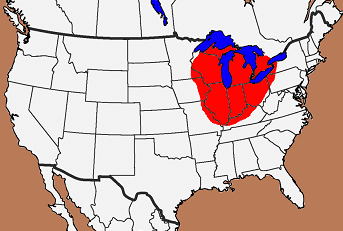
Similar Points:
Amos, Becker, Big Creek, Cupp, Dayton, Epps, Helton, Kings, Kirk Corner Notch, Lafayette, Motley, St Charles Dovetail, Stilwell, Thebes,
Vanport, Warrick Related / Associated Points:
Additional Comments:
These points are often smaller, thicker, and less
refined that similar Snyders points, They have deep broad notches
(Morrow, 2016)
These points may have served many different purposes from knives to
scrappers or points to ceremonial objects. The Snyders point has many
different variations that served different purposes or covered different
time spans. It is felt that the Hopewell and Snyders points may have been
used in ceremonial purposes while the Affis Snyders point and the Manker
point were more of the daily use points.
Others feel that the variations of points (Affis Snyders and Manker) may have been used by other cultures and not be true variations of the point (W11).
This point looks like a Snyders point, but it is a smaller, thicker, and does not have the higher quality workmanship as a Snyders point.
Point Validity: Valid Type
Montet-White is a distinguished
anthropologist and Professor Emeritus of anthropology at the University of Kansas. Montet – White has conducted extensive studies into the archaeology of the Ohio River valley. This point was named in a professional publication and has many professional references. This is considered a valid type.
.
Age Details:
This Middle Woodland Hopewell type dates between about 200 B.C.E. and 200
C.E. In Illinois, Manker points are part of the Havana Hopewell tradition,
and in Wisconsin it is associated with the Trempealeau Phase (Morrow, 2016)
Pictures Provided By:

Chris Ballard
John Mater
Kevin Leitz
References: (See Reference Page, Entry Number):
23, 168, W2, W11
Manker Projectile Point, Manker Arrowhead
